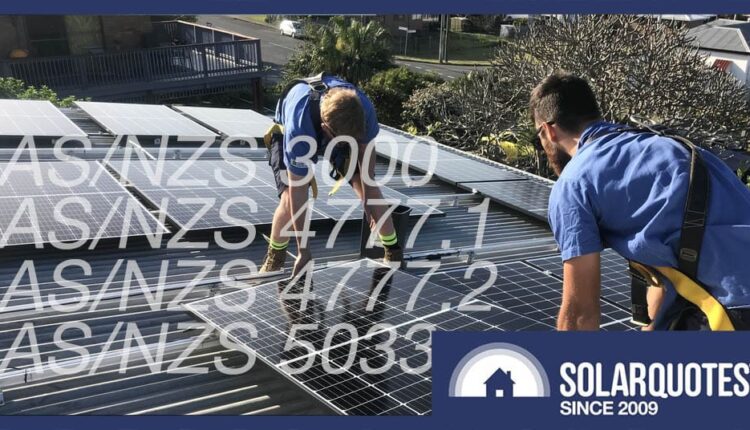Australian solar standards, regulations, rules and guidelines explained
Photo credit: MC Electrical
Whenever we discuss new rules or solar standards on the SolarQuotes blog, we invariably receive comments asking whether these rules apply to the commenter’s situation.
This blog explains the hierarchy of national standards, government regulations, DNSP rules and SAA guidelines and what this means for everyone who buys, uses and especially works with solar energy.
The Hierarchy of Electrical and Solar Codes
#1 Australian Standards
Australian National Standards are the cornerstone of safety and consistency in the Australian solar industry. The most important of these is AS/NZS 3000, known as the wiring rules, which supports other key standards such as AS/NZS 5033 for photovoltaic systems and AS/NZS 4777.1 for grid-connected energy systems. These standards govern critical installation and safety aspects, ensuring that all solar installations maintain a high level of safety, promoting public trust and supporting industry growth.
#2 State/Territory Regulations
Country-specific regulations also play an important role. For example, Victoria may have specific installation guidelines that differ slightly from those in Queensland or New South Wales and are tailored to local environmental conditions. Your electrician must follow both national and state codes.
An example of an electrical compliance certificate for a solar energy system, illustrating the detailed documentation required for regulatory compliance.
A focus on Victoria
Rather than go through the rules of every state and territory, as a Victorian electrician I will use the Victorian state rules as an example.
While Australian standards provide the framework, Victoria’s specific regulations, such as the Victorian Electrical Safety General Regulations (ESGR), adapt this framework to local needs. These regulations require compliance with important safety and technical requirements.
Victoria’s rules focus more on practical skills than theory. They also require strict inspections for solar installations, which are considered major electrical jobs. This differs from most other states, which do not require inspections and only take action if there is a problem.
#3 DNSP Rules – Connect to the network
Distribution Network Service Providers (DNSPs) play a crucial role when connecting solar systems to the grid. As owners and operators of the electric grid, DNSPs enforce specific regulatory standards to ensure that new connections do not jeopardize the integrity and security of the grid. This adds another layer of complexity for solar installers, especially in areas served by multiple DNSPs.
There are 14 different DNSPs across Australia, each of which may have its own connection requirements. However, one constant of all DNSPs is mandatory compliance with AS/NZS 3000, AS/NZS 4777.1 and AS/NZS 4777.2. AS/NZS 4777.1 covers the requirements for grid connection of power systems via inverters, while AS/NZS 4777.2 focuses on the inverter requirements for grid connection.
There are 14 DNSPs across Australia and this diagram shows the five across VIC. Your zip code determines your DNSP, and each DNSP has its own rules for connecting to its grid.
This can be a significant challenge for installers working in different states or regions with multiple DNSPs. Each DNSP may interpret and enforce these standards slightly differently, so installers must exercise extreme care and be well informed about the specific requirements of each DNSP they are working under.
Alex, one of the contractors I inspect systems for, says:
“Dealing with multiple DNSPs can be quite a headache, especially as a relatively new contractor in the solar industry.”
“Each area has its own rules and application procedures, and I have occasionally found myself mixing them up, which delays our installation schedules. It’s a learning curve that ensures we align with the right DNSP standards from the start.”
To effectively navigate this complicated landscape, solar professionals must establish strong communication links with DNSPs and stay abreast of any changes to their needs.
#4 SAA Guidelines: Required for STCs
Small-scale Technology Certificates (STCs), part of the Federal Government’s Small-scale Renewable Energy Scheme, are central to supporting the adoption of solar energy through the ‘solar rebate’. However, securing these benefits adds another layer of compliance – particularly the Solar Accreditation Australia (SAA) installation guidelines. These guidelines are the SAA’s interpretation/clarification of various Australian standards, including controversial rules such as solar oversizing limits. If your installer does not follow the latest guidelines, you will not be eligible for STCs for your new solar system.
Diploma
Solar professionals not only have to deal with Australian national standards, but also a variety of country-specific regulations, DNSP rules and SAA guidelines.
Different states’ rules can make compliance difficult, especially for plumbers who operate in multiple jurisdictions.
And it can be confusing to the layperson when reading about the latest rule or regulation updates. When we explain a rule in this blog in the future, we will clearly identify it as one of the following:
- an Australian standard
- a state/territory regulation
- a DNSP rule
- or a SAA policy required for STC creation
Then you can read this post to see if it concerns you.
Are you a solar professional or consumer interested in learning more about how these regulations impact your projects and investments? Join the discussion by sharing your experiences or asking questions in the comments below. If you require more detailed advice or need help with specific regulatory challenges, please do not hesitate to contact us. Let’s work together to ensure our transition to renewable energy is both efficient and safe.



Comments are closed.